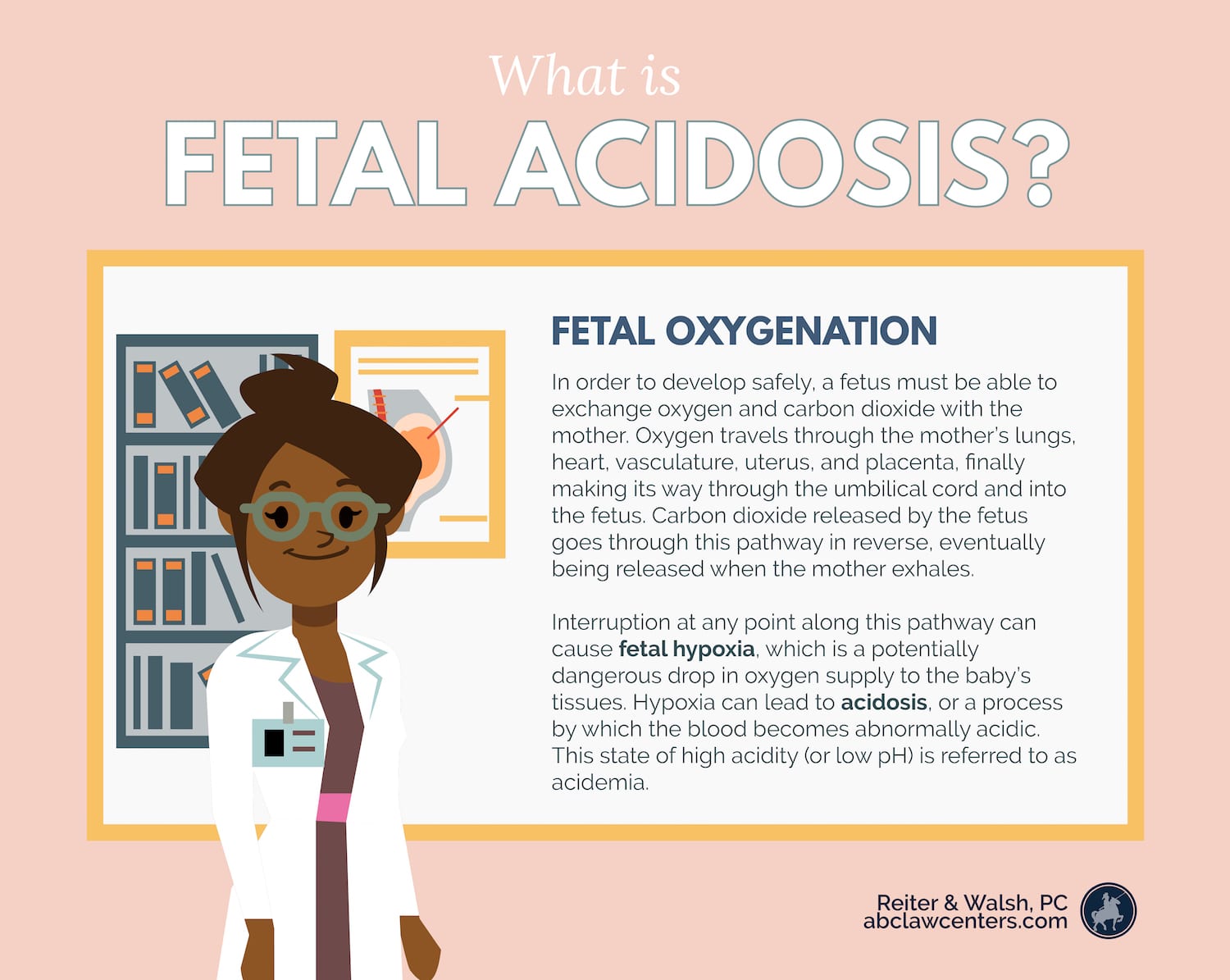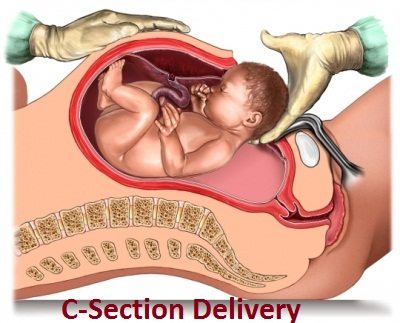Fetal Acidosis
In order to develop safely, a fetus must be able to exchange oxygen and carbon dioxide with the mother. Oxygen travels through the mother’s lungs, heart, vasculature, uterus, and placenta, finally making its way through the umbilical cord and into the fetus. Carbon dioxide released by the fetus goes through this pathway in reverse, eventually being released when the mother exhales. Interruption at any point along this pathway can cause fetal hypoxia, which is a potentially dangerous drop in oxygen supply to the baby’s tissues. Hypoxia can lead to acidosis, or a process by which the blood becomes abnormally acidic. This state of high acidity (or low pH) is referred to as acidemia (1).

Causes of fetal acidosis
In postnatal medicine, the causes of acidosis are often classified as respiratory or metabolic. However, fetal acidosis is often caused by a mix of respiratory and metabolic factors. The initial cause of fetal acidosis is usually respiratory, but without improvement in oxygenation, the fetus will resort to anaerobic metabolism in order to maintain basic bodily functions (2). Anaerobic metabolism yields less energy than aerobic metabolism and also results in the production of lactic acid. Metabolic acidosis occurs when there is a buildup of lactic acid (1).
Rather than distinguishing between respiratory and metabolic causes, it may be more useful to classify fetal acidosis cases as either acute (lasting for hours) or chronic (lasting for days).
Acute fetal acidosis can be caused by the following factors (2):
- Maternal: Maternal factors include complications that lead to low blood pressure (such as improper epidural use) or low blood volume (such as hemorrhage). Excessively strong or frequent uterine contractions can also lead to hypoxia and acidosis. Sometimes, this is caused by misuse of the labor-enhancing drugs Pitocin and Cytotec.
- Placental: Placental issues that disrupt uteroplacental circulation, such as placental abruption or uterine rupture, can have fast and profound impacts on the baby.
- Fetal circulation: Umbilical cord function is essential for adequate oxygenation. Various umbilical cord complications, such as true knot or cord prolapse, can quickly lead to fetal hypoxia and acidosis. Cord prolapse is sometimes caused by early amniotomy.
Chronic fetal acidosis can be caused by the following factors (2):
- Maternal: Chronic fetal acidosis can be caused by respiratory or cardiac disease in the mother, as well as reduced blood flow to the placenta due to complications such as preeclampsia.
- Placental: Reduced placental transfer of oxygen in pregnancies with intrauterine growth restriction (IUGR) can lead to fetal hypoxia and acidosis.
- Fetal: Some examples of conditions within the fetus that can lead to acidosis include feto-maternal hemorrhage and serious heart abnormalities.
Signs of fetal acidosis
In any pregnancy, it is critical that doctors test for signs of fetal distress. These are indications that the fetus may be in danger, potentially due to hypoxia and acidosis. Some signs of fetal distress may include:
- Decreased fetal movement
- Abnormalities seen on fetal monitoring
- Abnormalities seen on non-stress testing (NST) or contraction stress testing (CST)
- Abnormal amniotic fluid index (AFI)
- Abnormal biophysical profile (BPP) results
- Vaginal bleeding
- Maternal cramping
- Maternal high blood pressure
- Insufficient or excessive maternal weight gain

Diagnosing fetal acidosis
Hypoxia and acidosis can be diagnosed using the following tools, among other methods (2):
- Doppler ultrasonography
- Fetal heart rate monitoring
- Umbilical cord gas test
- The biophysical profile (BPP) score, which is composed of the following tests/measurements:
- A nonstress test (NST)
- Measurement of the amniotic fluid index/volume (AFI/AFV) using ultrasound
- Observation of fetal breathing movements
- Observation of gross body movements
- Observation of tone (reflex and extension movements)
Treatment of fetal acidosis
Fetuses who are experiencing hypoxia and acidosis often need to be delivered via emergency C-section. While preparing the mother for surgery, doctors should also give her oxygen, change her position, and increase her intravenous fluids. If a baby is born with acidemia, it is critical that medical professionals administer prompt treatment. Because acidosis is so highly correlated with hypoxia, this will likely involve therapeutic hypothermia, which can minimize the spread of brain damage after an infant has been deprived of oxygen. A baby with acidemia may also need other supportive treatments, such as medications to manage seizures. Long-term outcomes that can result from hypoxia and acidosis may also require certain treatments, therapies, and surgeries. To learn more about this, please click on the individual conditions listed under “Outcomes.”

Outcomes of fetal acidosis
Normal fetuses have coping mechanisms to withstand acidosis for short periods of time. However, if acidosis is very severe or chronic, it can cause death or lead to lifelong disabilities. These include (1, 3, 4):


Fetal Acidosis and medical malpractice
Fetal acidosis is often caused by medical malpractice. Examples of negligent actions that may lead to hypoxia and fetal acidosis include improper use of an epidural or labor-enhancing drug or early/unnecessary amniotomy (2). There can also be serious consequences if medical professionals fail to treat issues such as umbilical cord prolapse, or do not monitor for and promptly respond to signs of fetal distress. Many cases of severe hypoxia and acidosis result from the failure to provide an emergency C-section when one is indicated.
If you suspect that your child or loved one suffered from fetal acidosis as the result of medical negligence, you may want to consider pursuing legal action. The award-winning birth injury attorneys at ABC Law Centers: Birth Injury Lawyers focus exclusively on malpractice that occurs during pregnancy, delivery, or the neonatal period. They also work closely with an in-house medical team, which enables them to delve deeper into complex medical issues. To find out if you have a case, please reach out for a free case review. We have numerous testimonials and multi-million dollar verdicts and settlements that attest to our success, and you pay nothing unless we win your case.
Featured Videos
Posterior Position
Hypoxic-Ischemic Encephalopathy (HIE)

Featured Testimonial
What Our
Clients Say…
After the traumatic birth of my son, I was left confused, afraid, and seeking answers. We needed someone we could trust and depend on. ABC Law Centers: Birth Injury Lawyers was just that.
- Michael
Helpful resources
- Ayres-de-Campos, Diogo. “Acute Fetal Hypoxia/Acidosis.” Obstetric Emergencies. Springer International Publishing, 2017. 7-25.
- Bobrow, Catherine S., and Peter W. Soothill. “Causes and consequences of fetal acidosis.” Archives of Disease in Childhood-Fetal and Neonatal Edition 80.3 (1999): F246-F249.
- Low, J. A., Froese, A. F., Galbraith, R. S., Sauerbrei, E. E., McKinven, J. P., & Karchmar, E. J. (1990). The association of fetal and newborn metabolic acidosis with severe periventricular leukomalacia in the preterm newborn. American Journal of Obstetrics & Gynecology, 162(4), 977-982.
- Szpecht, D., Szymankiewicz, M., Nowak, I., & Gadzinowski, J. (2016). Intraventricular hemorrhage in neonates born before 32 weeks of gestation—retrospective analysis of risk factors. Child’s Nervous System, 32(8), 1399-1404.


